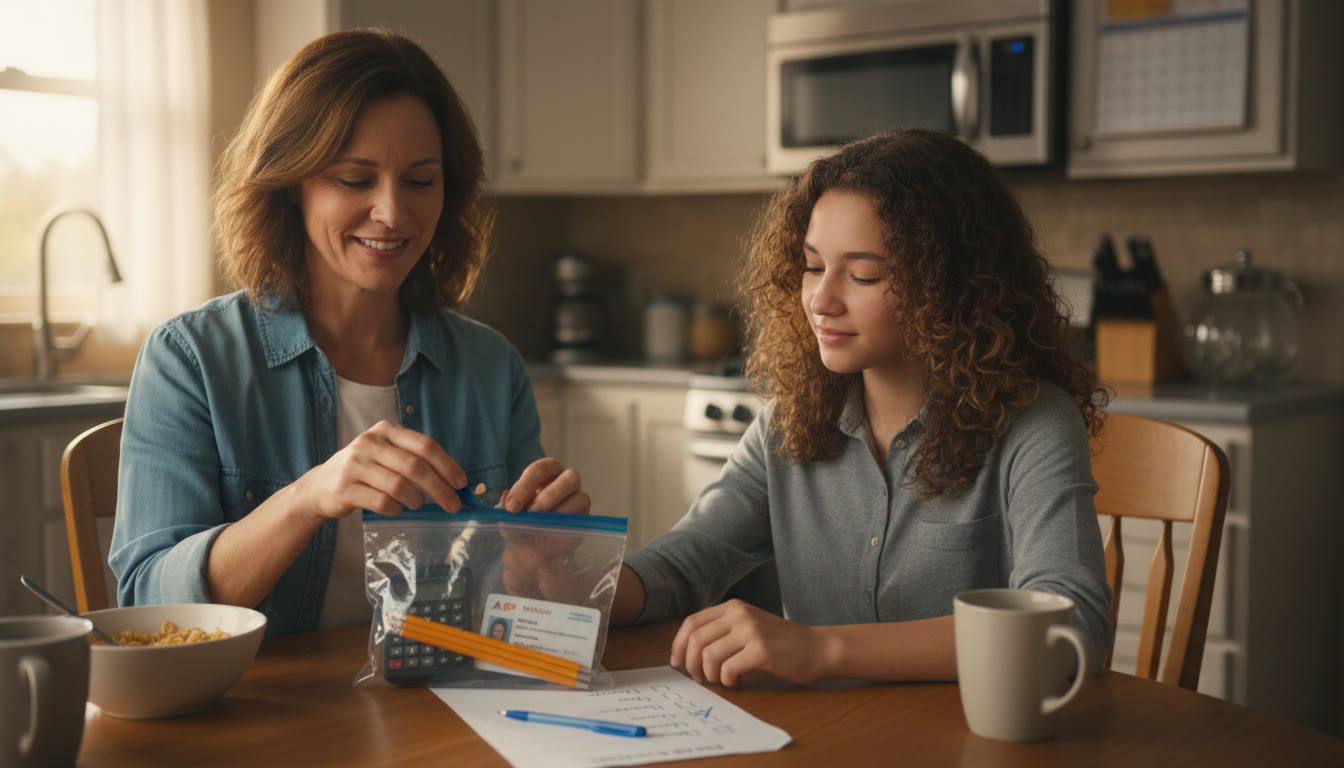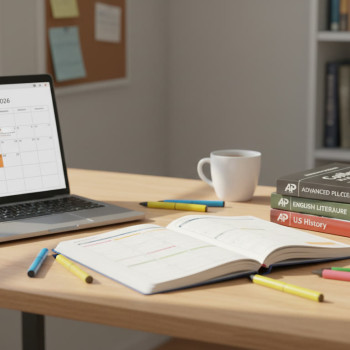Before We Start: Why a Parent Checklist Matters
There’s a certain energy to AP season — nervous, hopeful, and a little bit electric. As a parent, you’re the calm harbor in that storm. A thoughtful checklist doesn’t just prevent last-minute panic; it builds confidence. When your student walks into the room knowing they have everything they need, they’re already one step closer to doing their best.

Top-Level Rules to Know (The Quick Don’ts and Do’s)
Before you pack anything, get these high-level rules into your head and your teen’s: AP exams have strict security and administration rules. Some items are explicitly allowed; others are flatly prohibited. The consequences for bringing forbidden items are real — scores can be canceled — so it’s worth being precise.
- Do bring allowed tools for the specific exam (watches without alarms, approved calculators where permitted, pencils/pens as required).
- Do check whether the exam is fully digital, hybrid, or paper-based — that affects what your teen can bring.
- Don’t allow phones, smartwatches, earbuds, or any device that can connect to the internet in the testing room unless an accommodation specifically allows it.
- Don’t send notes, cheat sheets, or subject-related clothing. Even well-meaning study aids can lead to canceled scores.
What to Bring: The Master Parent Checklist
Below is a practical, parent-friendly checklist you can print or screenshot. Think of it as a “get-out-the-door” kit for exam day.
| Item | Who Needs It | Why It Matters |
|---|---|---|
| Photo ID (government or school-issued) | Students testing away from their home school | Required for identification at many test sites |
| Non-smartwatch watch | All students | Helps manage time during the exam without alarms |
| Approved calculator(s) (if allowed) | Calculus, Chemistry, Physics, Statistics, etc. | Some sections require or recommend specific calculator types; bring a backup if allowed |
| 2 No. 2 pencils (or mechanical pencils as permitted) | All students (especially paper/hybrid tests) | Pencils are needed for multiple-choice answer sheets and scratch work |
| Black or dark blue pens | Students taking exams requiring ink for free-response sections | Used to fill cover sheets or written responses where required |
| Charger and testing device (for digital exams) | Students using personal or school-provided devices | Essential to avoid on-site technical problems |
| Scratch paper and pens (if provided/allowed) | All students | Scratch paper is typically supplied by the proctor; bring a pen/pencil for notes |
| Comfortable layered clothing | All students | Testing rooms can be cool or warm; layers help concentration |
| Water bottle (if allowed) | All students | Hydration helps focus — confirm rules ahead of time about bottles |
Quick Tip: Pack the Night Before
Lay out the whole kit the evening before. Have your teen try turning on calculators and plugging in chargers to confirm everything works. Rehearse a calm departure time so arrival is relaxed. These small rehearsals reduce morning adrenaline.
What Not to Bring: Simple Rules That Avoid Big Problems
Some items seem harmless until you see the rulebook. Here’s what to leave at home or in the car. If you’re unsure about something (for example, an adaptive device used for study), check with the AP coordinator ahead of time.
- Smartphones, smartwatches, earbuds, and Bluetooth devices — even in pockets, they’re forbidden.
- Notes, flashcards, textbooks, or any written materials related to the subject.
- Reference guides, keyboard maps, or typing instructions for digital exams.
- Food, snacks, or drinks that aren’t preapproved (and noisy packaging). Quiet, non-strong-smelling snacks are best if you know they’re permitted during breaks.
- Clothing or accessories with subject-related formulas, timelines, or reminders.
A Word About Accessibility and Accommodations
If your child has approved accommodations, those often change what they can bring (assistive technology, separate testing space, additional time, or specific writing tools). Make sure accommodations are documented and confirmed with the school and the College Board well before test day.
Calculator Rules — A Parent-Friendly Guide
Calculators cause a lot of anxiety. Here’s a clear way to think about them:
- Know the exam: Only certain AP exams allow or require calculators. Check the specific subject rules.
- Bring allowable models: If your teen prefers a handheld calculator, confirm it’s on the approved list. For many exams, a built-in Desmos calculator is available in the testing app; for others, a handheld graphing or scientific calculator may be necessary.
- Bring a backup (if permitted): If allowed, bringing a second approved calculator can prevent a broken-device emergency.
Practice with the calculators your teen will use on test-style questions. Familiarity beats last-minute tinkering.
Digital Exam Considerations
More AP exams have moved to digital or hybrid formats. If your child is taking a digital exam, these are critical:
- Device and charger: Bring the assigned device or your student’s allowable laptop/tablet plus charger. Test the device ahead of time with any required testing software.
- Bluebook credentials: For College Board’s digital exams, students must sign in to Bluebook; saved passwords on the device won’t substitute for knowing the credentials. Make sure your teen knows their username and password.
- Scratch paper and pens: Digital exams often allow scratch paper supplied by the proctor — bring writing instruments.
At-Home Testing? Extra Precautions
If your teen tests at home, the testing environment must meet strict conditions — a quiet room, clear desk, no extra materials. The proctor or testing guidelines will outline permitted items. Parents often act as the “room supervisor,” so plan the space carefully and rehearse the process ahead of time.
Timing, Arrival, and Final Prep
Getting the logistics right is as important as packing the right tools.
- Arrive early: Plan for traffic, check-in time, and a few extra minutes of pre-test calm.
- Breakfast matters: A balanced meal (protein, whole grains, fruit) and water help concentration.
- Rest the night before: Encourage a sleep schedule during AP season rather than last-minute cramming.
Emergency Checklist: If Something Goes Wrong
Even with the best planning, things happen. Here’s a short emergency checklist for parents:
- Phone the AP coordinator immediately if a tech issue or unexpected problem arises.
- If a calculator dies and a backup is allowed, see if the testing site can provide an approved model.
- Keep calm: The proctors are trained to follow rules and sometimes offer solutions like re-scheduling in limited circumstances.
How to Use This Checklist with Your Teen (and Keep it Calm)
Turn the checklist into a ritual, not a lecture:
- Pack together the night before. Make it a quick, supportive session where you check items off aloud.
- Rehearse a “getting ready” timeline so your teen isn’t racing in the morning.
- Give a short pep talk: one or two sentences about effort, not outcomes. Example: “You prepared. You’re ready. Show them your work.”
Include Test Strategy, Not Just Supplies
Parents can help beyond gear. A quick review of test strategy the night before — time management, which sections to prioritize, how to mark and return to questions — can be reassuring. If your teen has been working with a tutor or a personalized program, a final 20-minute session the evening before can settle nerves and sharpen focus.
Where Targeted Support Can Help: A Note About Personalized Tutoring
Many families find it helpful to pair supply-day preparation with targeted academic support. Personalized 1-on-1 guidance and tailored study plans help address specific weak spots, so the student feels prepared on exam day — not just equipped. Services that combine expert tutors with AI-driven insights can accelerate progress by identifying the most impactful practice areas and adapting practice to the student’s pace.
If your teen benefits from structured, individualized prep, one last short session before the test — focused on pacing or a tricky topic — can be more calming than one more hour of unfocused review.
Sample Packing Plan (Timeline You Can Use)
Here’s a simple timeline you can follow the day before and the morning of the exam.
- Night Before (7–9 PM): Lay out clothes, pack the exam bag, test devices, and set alarm. Quick, light review of key formulas or vocab — no new material.
- Morning (2–3 hours before): Balanced breakfast, pack a light, quiet snack if allowed, test phone/chips are left at home, gather ID and watch.
- Departure (60–90 minutes before): Leave early to account for traffic. Arrive 30 minutes early to check in calmly.
Sample Check-In Conversation with Your Teen
Words matter. Here’s a calm script you might use at the door:
“You’ve done the work. I packed your kit and checked your calculator. Remember to pace yourself, skip and return when stuck, and breathe. I’ll be here after — no matter what.”
Final Thoughts: Make the Day a Positive Memory
AP exams are important, but they aren’t everything. Your calm presence, a reliable checklist, and a smoothly packed kit make a surprisingly large difference in how your teen feels walking into the room. Combine practical prep with emotional support — that balance helps students perform at their best.

Printable One-Page Checklist (Quick View)
Copy this short checklist to your phone or print it to keep in the car:
- ID (if needed)
- Non-smartwatch watch
- Approved calculator(s) + backup (if allowed)
- Chargers and testing device (for digital)
- 2 No. 2 pencils + eraser / pens (black or dark blue)
- Layered clothing
- Water bottle (confirm rules) and light snack (if permitted)
- Parking plan and arrival time
After the Exam: What Parents Can Do
Celebrate the effort, not the score. Do something small but kind: a quiet meal, time to decompress, or an activity your teen likes. If scores or feedback indicate missing skills, use it as a targeted roadmap for the next steps — tutoring sessions or a revised study plan can help turn a disappointing result into a growth opportunity.
A Note on Follow-Up Tutoring
If your teen wants targeted improvement, consider short bursts of focused tutoring on the specific skill areas flagged by the exam. Tailored 1-on-1 instruction makes it easier to close gaps efficiently and rebuild confidence.
Wrap-Up: Your Role Is the Steadying Hand
At the end of the day, parents don’t need to know every formula or historical date. Your role is to make sure the practicalities are handled and that your teen walks into the test with calm and focus. With a little planning — and this checklist — that’s exactly what will happen.
Good luck to your student. Pack the bag, get the sleep, and remind them you’re proud — that combination is quietly powerful.





















No Comments
Leave a comment Cancel